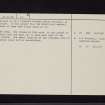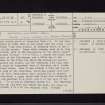Following the launch of trove.scot in February 2025 we are now planning the retiral of some of our webservices. Canmore will be switched off on 24th June 2025. Information about the closure can be found on the HES website: Retiral of HES web services | Historic Environment Scotland
Dumfries, Greystone Park
Human Remains (Period Unassigned), Stone Circle (Neolithic) - (Bronze Age), Cinerary Urn (Period Unassigned)
Site Name Dumfries, Greystone Park
Classification Human Remains (Period Unassigned), Stone Circle (Neolithic) - (Bronze Age), Cinerary Urn (Period Unassigned)
Canmore ID 65554
Site Number NX97NE 25
NGR NX 9798 7690
Datum OSGB36 - NGR
Permalink http://canmore.org.uk/site/65554
- Council Dumfries And Galloway
- Parish Dumfries
- Former Region Dumfries And Galloway
- Former District Nithsdale
- Former County Dumfries-shire
NX97NE 25 9798 7690.
A stone circle stood at Greystone Park. It had been destroyed by 1880, when it was noted that one stone - the Greystone - had been buried; it formerly stood on the N side of the circle. Three other stones, said to be from the circle, were in the foundations of "Mr Reid's house" (Greystone Cottage - O N B 1850), a fourth was built into the wall at the Mile-house, and a fifth lay at the entrance to the field (in which the circle had stood).
The latter two stones, and the Greystone (the only ones which could be inspected) were of Silurian grit, unlike the local rocks. When it was buried, a hole was dug on the N side of the Greystone, which was pushed over into it.
In 1887, excavations were carried out to recover the Greystone; a pygmy vessel was found with fragments of bone and charcoal at a point just S of the base of the stone. It is now in Dumfries Museum. The Greystone was dug up, and when the report was made, was lying on the ground, 8 ft N of its original site. Further excavations in 1887 revealed another stone belonging to the circle. It was larger than the Greystone; several fragments of bone were found close to it.
J Wilson 1888; A Morrison 1968
NX 9798 7690. Two stones at this spot, in the ground of Greystone Park are said (A E Truckell, Dumfries Museum) to have been part of the stone circle. The exact location of the original site of the circle could not be ascertained.
Visited by OS (EGC) 8 December 1960.










